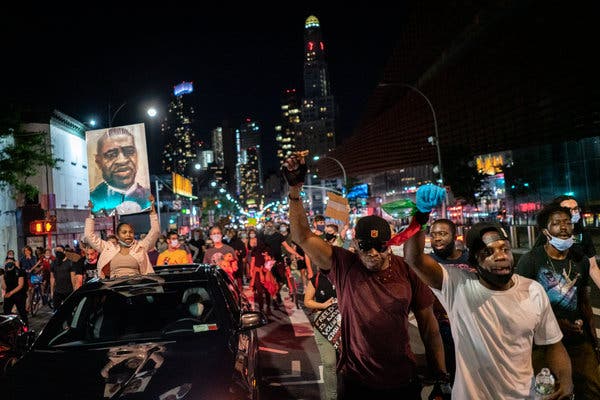For the first seven-and-a-half years of its existence, the plaza in front of the Barclays Center arena in Brooklyn was primarily a place that people passed through on their way to somewhere else. To the extent that it meant anything to anyone, it was, for some Brooklynites, a symbol of gentrification and displacement.
Then came the George Floyd protests.
On May 29, the second night of demonstrations in New York City, the plaza filled with a chanting crowd of thousands that spilled into the street and faced off against police officers who reacted to water bottles being tossed by pummeling protesters with batons, throwing them to the pavement, pepper-spraying state legislators and unwittingly helping galvanize a movement.
Ever since, the Barclays plaza, strategically located at the crossroads of the two biggest streets in the city’s most populous borough, has been synonymous with protest.
Just about every high-profile march in Brooklyn seems to either begin, end or pass through there. It was a place to launch attempts to seize the roadways of bridges into Manhattan, and a place to retreat to when those attempts were foiled.
In recent days, as protests have slowed, other events connected to the Black Lives Matter movement have continued: semi-spontaneous concerts, candlelight vigils, Friday afternoon Muslim prayers and public art projects.
The curious result is that the half-acre, pie-slice-shaped monument to corporate control of public space — formally known as Resorts World Casino NYC Plaza — has taken on a new character in the past two weeks: It is part of a community.
“I call it the mecca,” Rells Jones, 32, said on Saturday afternoon. She was helping at a voter registration information table that had popped up in front of the police barricades by the main entrance, while a few hundred demonstrators carrying signs filed into the plaza and her 9-year-old son skateboarded between clusters of people, in search of friends he had made during the protests.
“This is where everything happens,” Ms. Jones said.
The shift is particularly striking given the place’s tormented and not-too-distant history. The arena, which opened in 2012, is the centerpiece of a $6 billion redevelopment that was the subject of years of protests and lawsuits aimed at preventing it from getting built at all.
The mixed commercial and residential project, originally called Atlantic Yards and now known as Pacific Park, was made possible by a state “eminent domain” seizure that forced people to sell their property so that it could be demolished.
The project’s supporters pointed to the jobs it would create and the over 2,000 units of affordable housing it would contain, though most have yet to be built. Opponents called it a destroyer of community and a state giveaway to a powerful private developer.
Some of the same people who protested against Atlantic Yards found themselves feeling grateful for the plaza.
“When it was first built, I thought it was a waste of space,” said Margo Gibson, 51, who lives two blocks from the arena and recalled working bake sales for Develop Don’t Destroy Brooklyn, Atlantic Yards’ main foe. “And when I was there the other day I thought: It’s not enough.”
Before the arena and the plaza were built, the southeast corner of Flatbush and Atlantic Avenues did not have much on it — an empty lot behind concertina wire and an empty four-story building, once home to a supermarket-supplies company, that backed onto a train yard.
But the blocks behind it in the Prospect Heights neighborhood were home to several hundred people and small businesses that employed several hundred more, and by the early 2000s, the long-struggling area was in the midst of a revival.
So when New York State declared the whole area blighted in order to invoke the power of eminent domain, there was widespread resistance. In 2009, the state’s highest court ruled against the residents, and construction moved forward.
An open-air plaza in front of the arena was not part of the original design. The developer, Forest City Ratner, wanted to build an office tower there. But by 2010, amid the Great Recession, demand for office space in the area had evaporated and Forest City changed plans.
“The Plaza at the Barclays Center will quickly become one of Brooklyn’s great public spaces,” Bruce Ratner, Forest City’s president, said in a statement at the time. (As he told a reporter a year later, “You adjust to everything.”)
Despite a commanding location at the mouth of Brooklyn’s biggest subway hub and across the street from a shopping mall, the plaza saw little use except on event nights, when it briefly filled with visitors lining up to see a Brooklyn Nets basketball game or a New York Islanders hockey game or a concert or a pro wrestling match.
Until the protests came along, the plaza stood mostly empty.
Last week, a man named Ray Hands taped long scrolls of brown craft paper to the planters by the subway entrance for people to sign. Over the course of days, he collected hundreds of signatures and slogans.
“Tag up, tag up,” he called out to passers-by. “This is important. We’ve got markers here. Take a picture of your tag. This is famous!”
The throngs at the plaza have been noted approvingly by combatants from both sides of the original Atlantic Yards battle.
“I knew, way back when, that the plaza at Barclays would come in handy as a central spot for protest in Brooklyn,” Daniel Goldstein, a co-founder of Develop Don’t Destroy Brooklyn, wrote on Facebook. “One silver lining.”
Mr. Ratner, now retired, applauded, too. “I’m very happy that it has been a place where people can congregate and hopefully going forward a place where people feel comfortable and safe,” he said in a phone interview.
The arena and plaza are now run by a company headed by the billionaire Joseph Tsai, who bought the Brooklyn Nets last year. Mr. Tsai released a statement endorsing the protesters’ use of the plaza. “If it continues to serve as a place where everyone from our community — from residents to businesses to police alike — gather peacefully to listen to each other and find common ground, then it’s good with me,” he wrote.
The operators of the arena have taken the protests as an opportunity to change the messaging on the screen above the plaza. Gone is the rotating menu of ads for Geico insurance and JetBlue airlines and Dumbo Moving and Storage. In its place is a quote from the Rev. Dr. Martin Luther King Jr.: “The time is always right to do what is right.”
Living next to Brooklyn’s new town square has its drawbacks. Some residents of new buildings behind the arena have been less than thrilled to find their block used as a staging area by the police and turned into a security checkpoint.
“It’s invasive,” said Teresa Solomita, a psychotherapist who moved to her apartment on Dean Street a year ago. “I look out the window and I feel tense.”
At the same time, she said, she gets to watch history unfold: “People are talking and maybe the world will listen.”


















